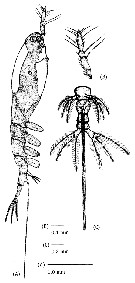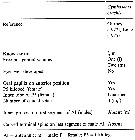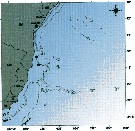|
|
 |
Fiche d'espèce de Copépode |
|
|
Monstrilloida ( Ordre ) |
|
|
|
Monstrillidae ( Famille ) |
|
|
|
Cymbasoma ( Genre ) |
|
|
| |
Cymbasoma gracile Gurney, 1927 (F,M) | |
| | | | | | | Syn.: | Monstrillopsis gracilis : Isaac, 1975 (n° 144/145, p.3, 6, 9, fig.F); Grygier, 1995 a (p.65); ? Holmes, 2001 (p.62);
no Monstrillopsis dubia : Vilela, 1968 (p.45, figs.F);
Cymbasoma gracilis :Sterza & Fernades, 2006 (p.95, Table 1, occurrence); Oliveira Dias & Costa Bonecker, 2007 (p.284: Rem); Oliveira Dias & al., 2008 (p.248, tab.1) | | | | Ref.: | | | Gurney, 1927 (p.169, figs.F,M); Al-Kholy, 1963 (p.134, fig.F); Dias & Araujo, 2006 (p.92, figs.F, Rem., chart, as C. gracilis); Suarez-Morales & al., 2006 (p.104, Rem.); Vives & Shmeleva, 2010 (p.160, figs.F,M, Rem.); Suarez-Morales & al., 2006 (p.104: Rem.). |  issued from : A.A. Al-Kholy in Publs mar. biol. Stn Ghardaqa, 1963, 12. [p.132, Figs.26-31]. Female (from Al-Ghardaqa, Red Sea): 26, habitus (ventral); 27, A1; 28, P4; 29, right P5; 30, left P5; 31, urosome. Nota: A1 4-segmented with 2 spines + 2 long setae at apex; abdomen 2-segmented; genital spine half the total length of body.
|
 issued from : C. de O. Dias & A.V. Araujo in Atlas Zoopl. reg. central da Zona Econ. exclus. brasileira, S.L. Costa Bonecker (Edit), 2006, Série Livros 21. [p.92]. Female (from Brazil).
|
 Issued from : E. Suarez-Morales, A. Bello-Smith & S. Palma in Zool. Anz., 2006, 245. [p.103, Table 1]. As Cymbasoma gracilis. Structural characteristics. Morphological characters for comparative morphology of the species assigned to the genus Monstrillopsis by different authorities. See : M. chilensis, M. dubioides, M. fosshageni, reticulata, sarsi, dubia, M. ferrari, M. zernovi, M; angustipes, Monstrillopsis sp.
|
 Issued from : R. Gurney in Trans. zool. Soc. London, 1927, 22. [p.169, Fig.28]. Female (Suez Canal): A, habitus (lateral); B, abdomen and P5 (ventral); C, A1. Male: D, abdomen (ventral); E, A1. Nota female: - Body very slender. - Relative length of A1, cephalotorax (head and 1st thoracic somite), and abdomen 35 : 12 : 17. - Proportion of cephalothorax and behind oral tubercle 19 : 103. - Abdomen 2-segmented, 2nd incompletely divided into two. - Furcal rami divergent, each with 3 setae. - Ovigerous spines separate, about half the total length of body. - A21 4-segmented, but the 3rd not distinctly jointed off; relative lengths of segments 12 : 219 : 13 : 50. - P5 deeply bifurcated, the outer branch bearing 3 long setae and extending as a lobe rather beyond the insertion of the setae. Nota male: - Less slender than female. - Abdomen 4-segmented, 3rd and 4th not completely separated. - Furcal rami with 3 setae only. - A1 larger than in female and composed of 5 segments, relative lengths 13 : 18 : 10 : 25 : 21. - Copulatory appendage with 2 narrow divergent lobes. - P5 absent.
| | | | | Ref. compl.: | | | Sewell, 1949 (p.142, Rem.); Grygier, 1994 a (p.28); 1995 a (p.65); Dias & Bonecker, 2007 (p.270, 272, fig.3, tab.II) | | | | NZ: | 2 + 1 douteuse | | |
|
Carte de distribution de Cymbasoma gracile par zones géographiques
|
| | |  issued from : C. de O. Dias & A.V. Araujo in Atlas Zoopl. reg. central da Zona Econ. exclus. brasileira, S.L. Costa Bonecker (Edit), 2006, Série Livros 21. [p.31]. issued from : C. de O. Dias & A.V. Araujo in Atlas Zoopl. reg. central da Zona Econ. exclus. brasileira, S.L. Costa Bonecker (Edit), 2006, Série Livros 21. [p.31].
Chart of occurrence in Brazilian waters (sampling between 16°-18° S).
Nota: sampling 2 specimens. |
| | | | Loc: | | | [? W Ireland, ? Channel of Bristol], Suez Canal (Suez, Amer Lakes), Red Sea, Brazil (Vitoria Bay, Natal-Pontal do Sul, Bahia State) | | | | N: | 5 | | | | Lg.: | | | (178) F: 1,84-1,8; M: 1,13; (728) F: 2; (995) F: 1,28-1,86*; (997) F: 0,9-1,97*; {F: 0,90-2,00; M: 1,13}
*: caudal rami excluded. | | | | Rem.: | For Suarez-Morales & al. (2006, p.104) underline that Isaac (1975) proposed to move this species of Gurney (1927) to Cymbasoma to Monstrillopsis, apparently based on the position of the mouth (no more than 0.25 of the way back along the ventral cephalothorax) and the development of the eyes. However, the presence of only 3 caudal setae in both sexes, combined with the structure of P5 female, the presence of only 1 free postgenital somite in the female and 2 in the male, makes it easy to reinstate this species in Cymbasoma. | | | Dernière mise à jour : 19/04/2020 | |
|
|
 Toute utilisation de ce site pour une publication sera mentionnée avec la référence suivante : Toute utilisation de ce site pour une publication sera mentionnée avec la référence suivante :
Razouls C., Desreumaux N., Kouwenberg J. et de Bovée F., 2005-2025. - Biodiversité des Copépodes planctoniques marins (morphologie, répartition géographique et données biologiques). Sorbonne Université, CNRS. Disponible sur http://copepodes.obs-banyuls.fr [Accédé le 23 octobre 2025] © copyright 2005-2025 Sorbonne Université, CNRS
|
|
 |
 |








